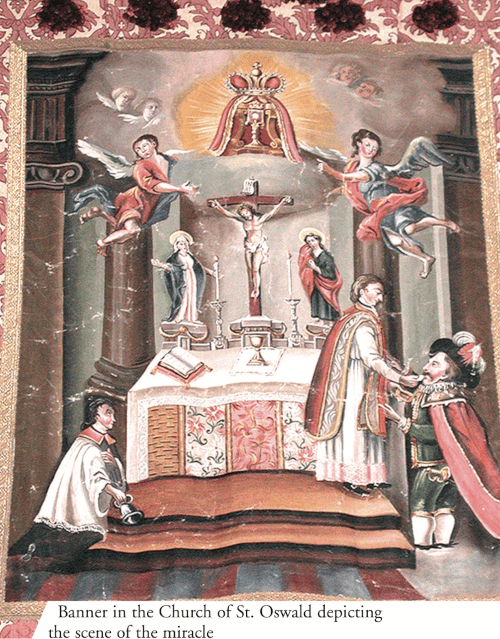Austria Seefeld (1384)
The Knight and the Bleeding Miracle

A Village Touched by Grace
In the quaint Tyrolean village of Seefeld, nestled amid snow-capped mountains and rolling meadows, a remarkable tale unfolded on Holy Thursday in 1384. The small parish church of St. Oswald, its stone walls steeped in the quiet piety of a humble farming community, became the stage for an event that would echo through the centuries.
The Arrogant Knight
Oswald Milser, a knight and lord of the nearby Schlossberg castle, strode into the church that evening with an air of arrogance that matched his towering presence. Known for his ruthless ways—imprisoning travelers and extorting their wealth—he was a man feared by many and humbled by none. As the Mass reached the moment of Communion, Milser, flanked by a band of armed men, approached the high altar with his sword unsheathed. His demand was brazen: he would not settle for the small host offered to the congregation. Only the large host, reserved for the priest, was worthy of his status.
The Ground Gives Way
The priest, trembling under the knight’s imposing gaze, dared not refuse. With hesitant hands, he placed the consecrated host into Milser’s mouth. The knight stood defiantly, refusing to kneel, his pride as unyielding as the blade at his side. But in an instant, the church itself seemed to shudder. The stone floor beneath Milser’s feet softened like quicksand, and he sank to his knees, swallowed up to his thighs by the quaking ground. Panic seized him as he clutched the altar, his fingers digging into the stone, leaving imprints that would endure as a testament to his desperation.
The Bleeding Host
The congregation gasped, their eyes wide with awe and terror. Milser’s face drained of color as he begged the priest to remove the host from his mouth. The moment it was retrieved, the ground grew firm once more, releasing him from its grasp. But the miracle was not yet complete. As the priest returned the host to the altar, a crimson stain appeared upon it—living blood, flowing as if from a fresh wound. The sacred host, now marked by this divine sign, bore witness to a power far greater than any earthly lord.
A Pilgrim’s Shrine Rises
Word of the miracle spread like wildfire across the land. Pilgrims flocked to Seefeld, their footsteps turning the sleepy village into a bustling shrine. The velvet cloak Milser had worn that fateful night was fashioned into a chasuble and gifted to the Stams monastery, a symbol of his penance. For the two years that remained of his life, the once-proud knight devoted himself to atonement, and at his death, he was buried near the chapel of the Blessed Sacrament, as he had requested.
The Church Transformed
The church, too small to hold the swelling crowds, was expanded in 1423 under the orders of Duke Friedrich IV. A silver monstrance, possibly donated by Milser himself, was crafted to enshrine the miraculous host, and in 1516, Emperor Maximilian I built an Augustinian monastery beside the church. Later, Archduke Ferdinand II added the Chapel of the Holy Blood to house the bloodstained relic. Paintings and frescoes adorned the walls, immortalizing the knight’s humbling and the host’s transformation.
A Legacy of Faith
Today, over six centuries later, the Church of St. Oswald stands as one of Austria’s most cherished pilgrimage sites. Visitors can peer through a grate at the hollow where Milser sank, see the handprints he left on the ancient altar—now preserved beneath a newer one—and marvel at the host, still bearing its sacred stain, kept in a gilded monstrance. Surrounded by the breathtaking beauty of the Tyrolean Alps, Seefeld offers not just a story of divine intervention, but a place where faith and history intertwine, inviting all who come to reflect on the mysteries of the Eucharist.